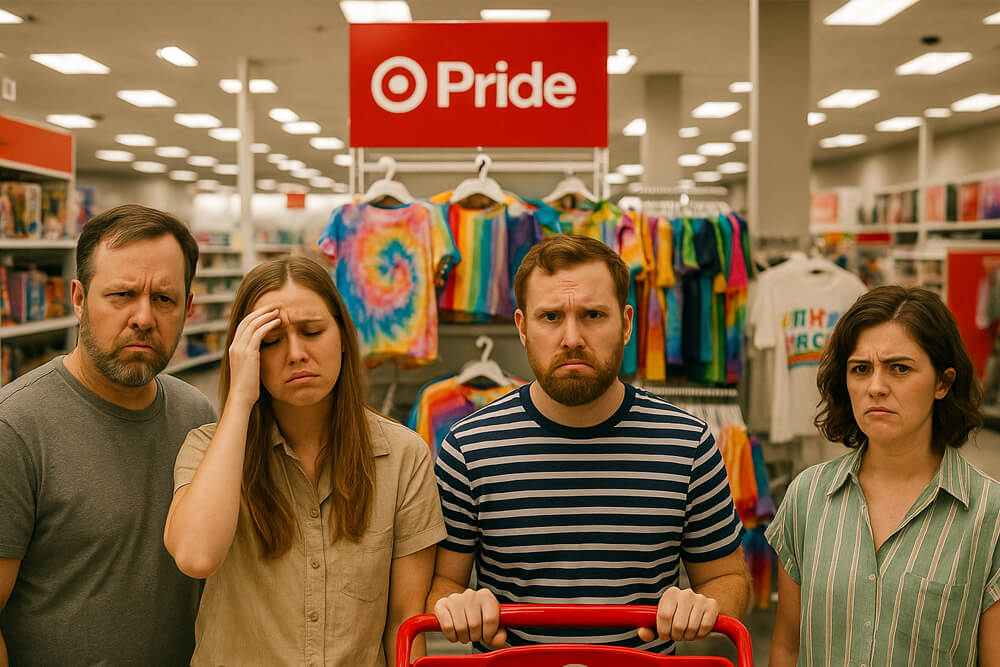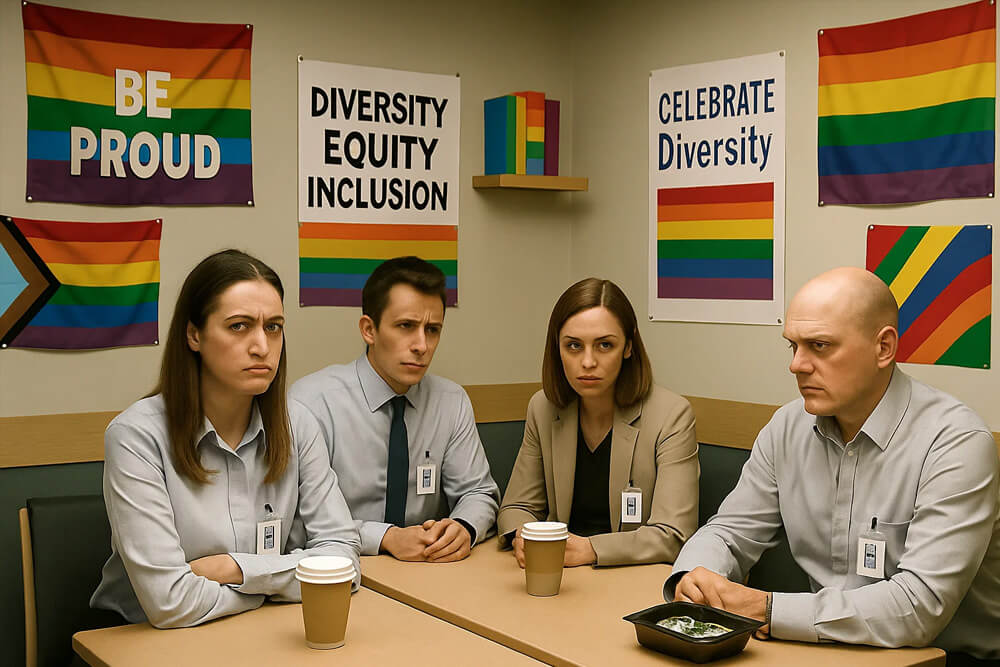Every brand wants to be loved. Some just try too hard. In the ESG era, companies aren’t content to sell products — they want to sell virtue. A coffee shop isn’t just a coffee shop. It’s a social justice hub. Your razor isn’t just for shaving — it’s here to deconstruct gender norms. Your beer now identifies as an ally.
But there’s a limit to how much signaling people can take before they roll their eyes, tune out, or walk away completely. It’s a phenomenon we call the Nickelback Law.
Defining the Nickelback Law
When a corporate virtue signal exceeds the audience’s background tolerance, the brand crosses into self-parody — triggering ridicule, consumer fatigue, and measurable decline. The harder a company tries to be loved for its values, the more likely it is to become a joke.

This doesn’t just happen overnight. It’s a cumulative effect — a saturation of slogans, rainbow flags, earnest campaigns, and pronoun declarations. It builds and builds until the public hits a psychological threshold. Not of hate. Of cringe. That’s when people start saying, “Oh God… not this again.” That’s when the Nickelback Threshold is crossed.
The RF Score: Measuring Brand Fatigue
We quantify this effect with a simple idea: RF — the Risk of Fatigue. When RF goes over 7.2, you’ve hit the Nickelback Threshold.
Formula: RF = v / (i × t)
Where:
v = campaign impressions per capita
i = ESG index uplift (basis points)
t = audience tolerance (baseline = 1.5)
RF > 7.2 = Nickelback Threshold breached
The more you blast the message, the faster you burn out goodwill. The lower your audience’s tolerance, the faster you become a meme.
Once RF > 7.2, every additional flag, hashtag, or “values” statement subtracts value instead of adding it.
The Nickelback Threshold
The Nickelback Threshold is the cultural breaking point where virtue signaling becomes unbearable. It’s not just that the campaign is political — it’s that it’s inescapable, overly engineered, and insultingly obvious.
Crossing the threshold doesn’t require malice. It requires overexposure. When your message stops feeling meaningful and starts feeling mandatory, you’re no longer inspiring anyone — you’re annoying them.
This is when your DEI campaign becomes a meme. When your rainbow-wrapped forklift goes viral for all the wrong reasons. When the Risk of Fatigue (RF) score crosses 7.2, you’re no longer marketing — you’re broadcasting cringe.
At that point, every new ESG activation doesn’t help your brand. It hurts it. You’ve become a parody of your own sincerity.
Why It’s Called the Nickelback Law
Nickelback, the Canadian rock band, wasn’t hated for being bad — they were hated for being everywhere. They tried so hard to be universally liked that they became a punchline. Their saturation outpaced their substance. That’s what’s happening to brands today.

That’s what’s happening to brands today. They’re plastering over mediocre products with messaging campaigns designed by midwit HR cultists. They aren’t connecting with customers — they’re drowning them in ideology. And the public sees through it.
When Cringe Becomes Fatal
You don’t lose your audience because your campaign is offensive. You lose them because it’s embarrassing.
A rainbow-wrapped beer can isn’t brave. It’s Nickelback. A Pride forklift isn’t inclusive. It’s Nickelback. Your monthly DEI email blast? It’s Nickelback. Swapping out your entire visual demographic overnight to chase a diversity quota isn’t progress. It’s Nickelback.
It’s not hate. It’s cringe. And cringe is fatal. No one wants to buy from a brand that looks like it’s trying too hard to be liked — especially if it used to just sell good products.
Brand Fatigue Is the New Silent Majority
Most Americans didn’t ask for this. They didn’t demand ideology at the checkout aisle. They just wanted to live their lives. But now every billboard is a sermon. Every app update comes with a pronoun tutorial. Every t-shirt comes preloaded with moral instruction.

So they’re walking away. First with a laugh. Then with their wallets.
When Desperation Becomes a Moral Test
There’s something worse than trying too hard to be liked. It’s expecting applause for it — and calling your audience bigots when they don’t clap.
That’s where ESG marketing ends up. It’s not just branding. It’s emotional blackmail in a press release. You’re no longer allowed to just buy coffee or beer or clothes. You’re required to like the company. To affirm the campaign. To approve of the values.
If you don’t — if you blink, pause, or just shrug — you’re labeled a problem, a hater, a denier. That’s not a customer satisfaction strategy. It’s a hostage negotiation.
Real-World Proof: The Nickelback Law Is Measurable
The Nickelback Law isn’t just a metaphor — it’s playing out in boardrooms and balance sheets across America.
Bud Light (Anheuser-Busch)
Q2 2023 sales declined by 26%, with over $390 million in lost revenue following the Dylan Mulvaney Pride partnership.
(Heineken USA & Stifel, Aug 2023)
Target
Stock value fell by $14 billion after the Pride toddler clothing controversy. Foot traffic collapsed in the South and Midwest. Store managers faced in-person confrontations and boycotts.
(Reuters, June 2023)
Nike
The Mulvaney sports bra campaign triggered backlash, especially among Gen X and millennial males. Financial impact was partially insulated by global markets, but cultural damage stuck.
Risk Response
ESG scoring firms like MSCI and Sustainalytics now track backlash-adjusted metrics, including social sentiment. Passive ETFs are no longer blindly rewarding rainbow-wrapped virtue. They’re measuring results — and red flags.
Theoretical Support
Reactance theory shows that forced moral messaging triggers defiance. Marketing fatigue theory explains how repetition turns virtue into noise. And virtue fatigue? That’s what we’re all living through now.
Legal Thresholds
Internal hiring dashboards that reward race over merit are now under scrutiny. “Pattern-or-Practice” systems that discriminate — even for “good” reasons — violate 42 U.S.C. §2000e-2(k) of the Civil Rights Act. It’s not activism. It’s illegal.

Once the cost of compliance exceeds the ESG boost, the ROI flips negative — and the Nickelback Threshold is breached.
Redemption Is Possible
The Nickelback Law isn’t a death sentence. It’s a warning label.
You don’t need fifteen flags to prove you care. You don’t have to turn your packaging into a UN press release. You can sell products again. You can focus on quality instead of cult compliance.
It’s not too late to throw off the ESG shackles. Not too late to tell the consultants and compliance clerics to go home. Not too late to remember that your job is to serve your customers — not re-educate them, not morally posture, and not break federal law.
Because here’s the truth: race-based hiring is illegal. Title VII doesn’t care how noble your intentions are. A “pattern or practice” of demographic engineering is still discrimination — no matter how colorful the dashboard.
Put the flags away. Fire the quota kings. Make something worth buying.
Even Nickelback fought against Nickelback… and reclaimed its soul.
You can too.
—Wolfshead





Does not quite fall under Nickelback Law, but Jaguar “Copy Nothing” and their “Type 00” (double zero is fitting) can fight with Bud Light for the throne of self-destruction. Arguably they win IMO, as Jaguar might not survive this. Also incredible to see, google “Katjes Bill Kaulitz” and watch the Youtube Video, another family heir gone woke/nuts. Katjes is selling gummy candy, and now even candy has gone woke and vegan.
They are doing civilization a favor, the more they expose themselves, the more people will finally wake up and get fed up with them.